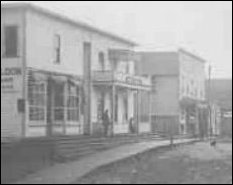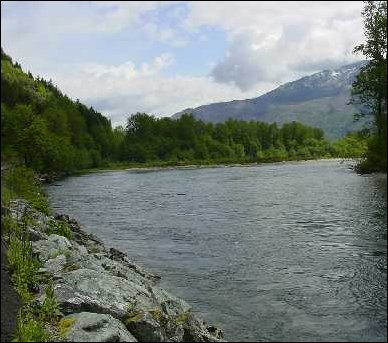Utopia features:
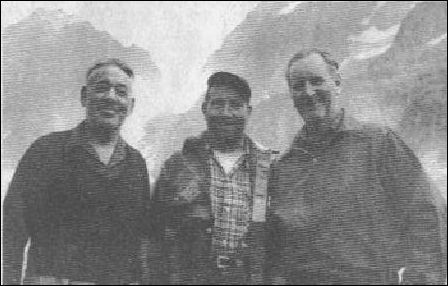 | From l. to r.: Brown Wiseman, Raleigh Wiseman and Chuck Dwelley
while climbing the North Cascades in an unknown year before 1975, after
Brown planted fish in the mountain lakes. Click on photo for story. The
story can be found at
this address.
|
- We have spent the last two years visiting and researching with descendants of the pioneers of the Utopia district near Lyman for a section we plan later this month. Can you help with memories or scans of photos? We are looking for: Betscharts, Kings, Seversons, Powells, Atwells, Leggetts, Reisches, Johnsons, Silverthorns, Utopia school alumni, Marchants, Giffords, McConnells, McCalibs, Minklers, George Arnolds, Daesners, Behrens and anyone else who lived there. Please email us if you know details and pass this on to anyone you might know from those families.
- During Founders Days the 1914 bank robbery is reenacted, but the Bingham Bank was robbed in 1933 and people are still alive who remember the sadness that gripped Sedro-Woolley when night watchman
Carl Strom of Utopia was murdered.
-
Brown Wiseman planted fish in high-country, North Cascades lakes and streams in the 1920s and '30s while he was a schoolteacher. Also includes his experience with the True-Love Bandit in 1914. This story will soon be changed to this address. If neither file connects, please email us.
Helen Mathews Burns, now 91, recalls her childhood home in the Utopia district — also the home of your humble editor, and her father, James Hood Mathews. Includes the story of their relatives, the pioneer George Brosseau and family of Sterling and old Sedro, and their friends, the Reische and Atwell families of Utopia.
- Alexander Ross, who homesteaded an island in the Utopia district of the Skagit river and imported fine cattle after a life on the bounding main. We find that he was lured to this area by David Batey, one of the four bachelors who settled future Sedro, when Batey and Ross met in San Francisco.
- The late Bill Newberg, the boy from the Utopia area who graduated in 1929 and went on to help engineer the construction of B-29s in World War II and then ascended to the presidency of Dodge and Chrysler. Interview at age 92. This story will soon be changed to this address. If neither file connects, please email us.
Links for the Skiyou District, between Sedro-Woolley and Utopia
Lyman and Cockreham Island features
- Timeline of early Lyman
- In 2002, we launched our first story of famed upriver pioneer Birdsey Minkler. Now you can read the full two-part story on Birdsey, his mill, his family and the upper Skagit river that results from ten years of research and correspondence with his descendents. This links to the story of how the Minkler Mansion is being proposed as the new city hall and how you can get involved.
- We have found and shared evidence that answers several questions about the mysterious death of Garfield Minkler, Birdsey's son, in his own store in Lyman on May 19, 1920.
- The Bratlie family story, obituary and transcripts. Mary Belle "Matie" Minkler Bratlie, was the sixth child of the upriver-Skagit pioneer Birdsey D. Minkler and she lived to age 109. In 1907 she married Hans J. Bratlie, a Norwegian immigrant, and they published the Herald, first in Hamilton and Concrete. The newspaper burned in the great Concrete fire of 1915 and they moved to Ridgefield, where they were partners in a very large Western red cedar mill. This story will soon be changed to this address. If neither file connects, please email us.
- How Lyman was named for an attorney from Helena, Montana, during the 1880 Ruby Creek gold rush. The annual Lyman Picnic is scheduled annually for the second Saturday in August.
- Lyman, Part One: earliest settlers and homesteaders, including A.R. Williamson, Valentine Adam and Henry Cooper and town namesake, Lorenzo Lyman. earliest businesses, the Skagit River's effect on the town, the Otto Klement and Birdsey Minkler eras. Two part story; part two has capsule history of the 24 earliest families.
- Mike Aiken shares a November 1878 issues of C.B. Bagley's Puget Sound Weekly Courier, and the story of how the Upper Skagit was opened to settlement and logging that year as the log jams were conquered and our most important upriver pioneers staked their claims, including Mike's great-grandfather, Birdsey Minkler.
- A new series begins on Fishing on the Skagit and its Streams by the late Cecil Hittson. Number One. Part Two is coming soon. This story will soon be changed to this address. If neither file connects, please email us.
- A brief biography of Otto Klement, who paddled across Puget Sound in 1873 and became one of the Skagit Valley's first permanent settlers, before becoming the Lord of Lyman. This portal section has been updated with more Klement stories, including excerpts from his 1926 diary, and it is now updated with the first known Klement photos, through the kindness of Bud Meyers.
- Chapter 2: Hogtied! Good old boys in 1882 Lyman — Boredom, devil rum, hijinks, greed and frontier humor, from Otto Klement's diary.
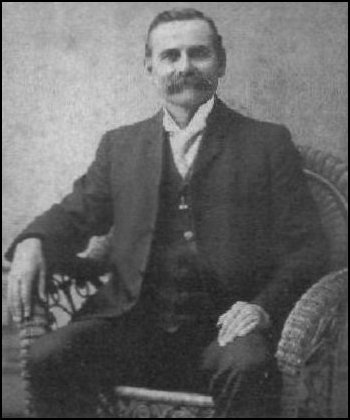 | Otto Klement. Photo courtesy of Bud Meyers.
|
- More excerpts from Otto Klement's memoirs, the man who arrived in the valley in 1873 and became the father of Lyman in 1881: the early years . . . Farming methods and earthquakes 1870s & '80s . . . winter weather and frozen Skagit River . . . Otto led teams of pioneers back and forth across the Cascades Pass, and Julian Itter painted it and Mary Roberts Rinehart wrote about it extensively after crossing it with her sons.
- Chapter 4: Otto and other settlers and Indian guides cross the pass in 1877 in search of gold, and also find bear to hunt and a goat who loved their boat. This story will soon be changed to this address. If neither file connects, please email us.
- And the newest story from Klement's diary: excerpts from his 1926 diary details the logging methods that he encountered on the Olympic Peninsula in 1873, a few months before paddling across Puget sound to the Skagit valley. This story will soon be changed to this address. If neither file connects, please email us.
- Chapter 3: Otto's arrival on the Skagit. How he came to Washington Territory in 1873 and paddled across Puget Sound in a cedar canoe. This story will soon be changed to this address. If neither file connects, please email us.
- Lyman Tavern Fire of Feb. 9, 1950, and Cecil Hittson's memories of fighting the fire. This story will soon be changed to this address. If neither file connects, please email us.
- Peter Trueman, who homesteaded in the Cascades and then moved downriver to Lyman, where he sank down roots and married the widow of Birdsey Minkler's original Lyman sawmill partner. Members of the Trueman family still lives in Lyman today. This story will soon be changed to this address. If neither file connects, please email us.
- Do you know anything about Cochreham Island, or the Cockreham and Cochreham families of the upper Skagit river? Or do you know of the Tingleys of Happy Valley/Day Creek? If so, please email us.
- Samuel Simpson Tingley Part One, Washington Territory pioneer of 1859, who settled on the north fork of the Skagit in 1867 and then Day Creek in 1880. From Maine boyhood through Civil War and meeting his first wife, a Mercer Girl on the ship to Washington Territory. Part Two: Settles at South Fork, raises family, blacksmith in Mount Vernon, loses first wife, marries again to doctoress, settles at Day Creek, builds boats and ferries for Skagit River.
Hamilton features:
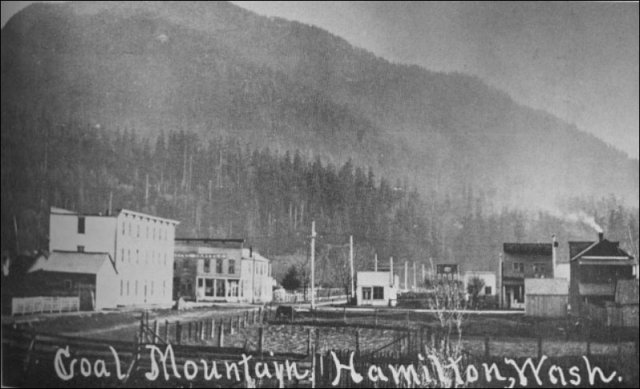
|
This undated photograph was often printed on postcards [*see next paragraph] See next paragraph near the turn of the 20th century. It is a truly a puzzlement, as people might have said back then, because most of the building are news to anyone who has seen the photo. We have no idea who the photographer was or what year the photo was taken, much less are we sure of which streets are crossing. At first, we thought that the view is looking south over the young town of Hamilton, with Coal mountain looming behind on the south shore of the Skagit river. That would mean that the streets are: diagonal-left-to-right — Cumberland Street, and horizontal — Maple Street.Or . . . are we looking west-southwest at the same streets, but switched in direction? We have begun to wonder about this because of the mountains in the background and the curved slopes of Iron Mountain and Coal Mountain. Just to confuse matters further, was this photo [*see next paragraph] taken before the disastrous 1897 flood that wiped out the early town by the river — i.e., could the diagonal street be Cumberland and is the horizontal street, Water Street, which is now covered by the Skagit River? We hope a reader can identify when it was taken, in what direction and what the buildings are in the photo. This is truly one of the most mysterious and fascinating photos that have been passed down in family collections from generation to generations.
*One of our sponsors shows how many people are printing photos like this at home using high quality Dell toner. Discover how to do this on your own computer at this Dell link here and here.
|
Research of early Hamilton
- Read the first two chapters of our exclusive Hamilton story. Chapter 1 covers settlement from the days in 1873 when Amasa Everett and others starting prospecting at Coal and Iron mountains. From there you will find Chapter 2 about William Hamilton and family coming in 1877 and their effect on the town over the next century. More sections of Chapter 3 will be added in 2010 to profile the early families who were caught by the many floods but were not intimidated, and the early days of the city from the 1880s through the Depression of 1893-96 and beyond. We hope you will share your family memories and photos.
- Read a profile of frontier columnist Frank Wilkeson and his famous family. Frank was a Civil War vet who wrote a noted book about the war and he helped boom the towns of Sedro and Hamilton. A New York state native, he explored the Skagit river system in 1870, mined and farmed in the Midwest, then returned to the Northwest to live in Fairhaven at least part of the year. He owned a mining store near Stehekin and wrote columns for the New York Times and Sun, especially about fishing in the Skagit region. This section, courtesy of Wilkeson biographer Patricia McAndrew, includes 16 of his columns. You can also read about her new Wilkeson book, in collaboration with the Journal editor — The Old Soldier Goes Fishing, which is scheduled for publication in 2012-13. This story will soon be changed to this address. If neither file connects, please email us.
- Read about fishing for Humpback salmon and trout with his friend and Hamilton pioneer, Ike Morrell, in 1892. This story will soon be changed to this address. If neither file connects, please email us.
- Frank wrote a series of columns in 1891 about the richness of the Skagit valley. "Five Thousand Five Hundred Square Miles of the richest lands in the world: No need for commercial manure here!" Agriculture, silver and coal from Sedro to Hamilton and the foothills of the Cascades.
- In 1891, Frank surveyed the whole valley and the foothills for coal deposits and mines, including the little town northeast of Woolley that would become known as Cokedale. This story will soon be changed to this address. If neither file connects, please email us.
- The 1906 Illustrated History described Hamilton to the point, the predicted "Pittsburgh of the West."
- James Cochrane, Hamilton pioneer and a volunteer on the logjam clearing team of 1877-79. This story will soon be changed to this address. If neither file connects, please email us.
- Gar Green, Hamilton/Birdsview pioneer, his family, and his friends, Mollie and Wallie Dowdle, with correspondence from some of his relatives. This story will soon be changed to this address. If neither file connects, please email us.
- Story of the 1925 fire that leveled Hamilton.
- R.I.P. Fred Slipper, 1917-2007.
- See our exclusive Journal story of the Slipper and Sprinkle families, who influenced the town of Hamilton from 1890 on and their Hamilton home, which now serves as a museum. Can you help us with family memories from the Hamilton/Birdsview area? We want to profile all the families from pre-World War I onwards in upcoming special features; can you help with copies of documents, articles and photos?
- John Slipper's hilarious 1942 letter to the Sedro-Woolley Courier-Times, with many anecdotes about Hamilton and the Skagit River. All Slipper stories shared from Issue 41 of the Subscribers Edition.
- Newspaper stories and web sites about Bert Huntoon, the Huntoon brothers, Bert's photography, Cascade Pass and Mount Baker. This story will soon be changed to this address. If neither file connects, please email us.
- Huntoon brothers, John and Isaac D., and their booming and real estate activities in Hamilton, Anacortes and Idaho. This story will soon be changed to this address. If neither file connects, please email us.
- Photos of the Hamilton area from Lois Pinelli Theodoratus.
- Lafayette Stevens, the Skagit pioneer from 1873 who used his Nevada mining skills to prospect for coal near Hamilton, find the coal fields that led to Cokedale and became the most noted mining speculator on the Skagit river.
- Cub Ramsey and his wonderful life. Fishing and hunting from Arkansas to Punkin Center near Hamilton. Cub's wife, Theona, has also passed away and her obituary is added to the story. This story will soon be changed to this address. If neither file connects, please email us.
- This capsule biography file features Hamilton pioneers, William J.S. Gordon and Marshal Edward and Bessie Luton. With more notes about Gordon's brother-in-law James J. Conner, and Bessie's sister Olive, who married Fidalgo pioneer William Munks. This story will soon be changed to this address. If neither file connects, please email us.
Mollie Dowdle stories
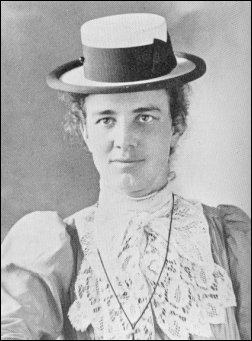 | Sadie Silverling Cudworth came to Marblemount in 1909 and for the next six decades she hosted folks at her hotel. We plan to feature her life extensively in 2012 along with Herman Rhode, the packer who lived at the hotel. We are still researching and we hope that readers can help, with memories, documents or photos. We especially hope to hear from descendants of Hugh Cudworth, her husband. He was from Whatcom County and sometime in the late Teen years or the early 1920s he moved away to Hollywood, and worked with the silent movies.
|
- Introduction to the late Mollie Dowdle and links to all her stories that are transcribed in the Journal. An emigre from North Carolina, she became a voice for Tarheels and country folk in the Skagit Valley and the North Cascades.
- Mollie Dowdle lived to the age of 97 and she had quite a gene pool. In this 1963 column, she told us about her father, his Tarheel values and how her family maintained the values and culture in Hamilton and the upper Skagit River.
- In a 1966 column, Mollie reflected on her Tarheel ancestry and eternal laughter with her upper Skagit River family.
- In a 1975 column, Mollie Dowdle wrote about springtime along the fence and behind the barn on the family's upper Skagit River farm, and the ubiquitous cottonwood trees.
- In a 1963 column, Mollie wrote about her mother and the challenge she faced with her family, setting up a home clear across the country.
- Mollie tells the story of how her beloved grandfather, Malcolm Wood, moved his family and four-year-old Mollie out to the Skagit Valley from North Carolina, where poverty, disease and death had taken several of them while very young.
- We especially thank Pat Hegg Brown, Deanna Ammons, Bernie Leaf and Larry Spurling for the large collection of articles that they have shared with us, some of which includes these columns. We encourage readers to share similar columns with us. We also welcome copies of old newspapers, especially those before 1920 and copies of the annual Puget Sound Mail Pioneer Picnic special editions of any year. We never ask for your originals. Please either send us scans or for copies, you can find our mail address at the top or bottom of this story.
- Stories of the upper Skagit River Quall and Cary families by Mollie Dowdle; memories of the families and the 1916 reunion by Gladys Ellis Pape Miller, descendant of the Savage and Boyd families; and Journal research.
- Pioneer cemetery of the Qualls and Carys, by Mollie Dowdle, from her 1985 book, My Best Loved Stories.
- Mollie Dowdle tells the story of little Gar Green learning the facts of life as midwife Mrs. Tingley races to deliver a Pioneer Baby. This story will soon be changed to this address. If neither file connects, please email us.
- Mollie Dowdle shares her favorite Christmas memories, when her son Wal shipped out for service in the Korean War before Christmas 1952. For anyone who knows Wal, you will love the story of how he played Santa Claus while there.
- What is your favorite Mollie story? Let us know and we will put it on our list to transcribe.
Profiles of Frank Wilkeson and a collection
of his columns written while living here
See a list of links to all of Frank Wilkeson's columns on our site. Most of them are about fishing and hunting in the area from old Sedro, across the Cascades to Lake Chelan. And read about Patricia N. McAndrew's new book, The Old Soldier Goes Fishing — planned for publication in 2012-13, a collection of his columns and a biography of Frank and his family, with chapters by the Skagit River Journal editor.
Birdsview features/Baker Lake:
- Mabel Boyd Royal's memories of her father, Lewis A. Boyd. Sailor, farmer, first upper Skagit river schoolmaster, Skagit county clerk, story in two parts.
- The story of the L.A. Boyd family by his son, Archie Boyd. Years after sailing around the world, L.A. was the first schoolmaster upriver and was later Skagit county clerk.
- Little Mabel Boyd [married: Tom Royal and Ollie Steen], joins her Hoyt relatives on a wagon trip from Prairie around Lake Whatcom to Fairhaven for Fourth of July 1897.
- You can read much more about Mabel Boyd Royal Steen and her father, L.A. Boyd, the first upriver schoolmaster, at the Journal Portal Section or at the Stump Ranch website assembled by her great-grandson, Dan Royal.
- Read about Frank Wilkeson taking his son and friends for a fishing trip on Grandy Lake. This story will soon be changed to this address. If neither file connects, please email us.
- George Savage profile: 1916 autobiography of 1878 Birdsview settler and first county surveyor.
- How George Savage participated in the tricky maneuver that separated the new Skagit County from Whatcom County in 1883. This story will soon be changed to this address. If neither file connects, please email us.
- Katy Pulsipher, daughter of the famous George and Georgetta Savage family and poet and historian of the Birdsview area of the upper Skagit river. She is profiled in this 1970 newspaper article.
- Portal section with links for Catherine "Katy" Pulipher.
- A 1971 letter from Birdsview pioneer Catherine Savage Pulsipher that reveals her identity as Mountain Katy in June Burn's book, Living High.
- August and Barbara Kemmerich family, Birdsview settlers.
- James and Alice (Jarman) Elliott and their 1890s hotel in the planned town of Bessemer, which faded in favor of nearby Birdsview.
- At Dan Royal's website, The Stump Ranch, you will find a walking tour of Birdsview with the history of the twin villages, Birdsview and Bessemer, and the pioneers who lived there and dreamed of a city some day among the stumps.
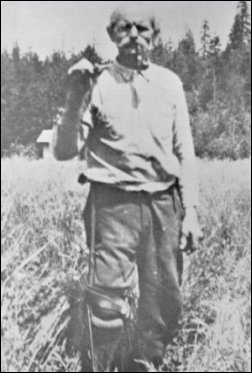 |
Amasa Pegleg Everett, on his homestead on the east side of the Baker river, circa the turn of the 20th century. Click photo for his story.
|
Concrete/Baker river features:
- What's New in Concrete, including the reopening of the historic Concrete Theatre on Feb. 12, 2010.
- Portal to section about Charles Dwelley, longtime-editor of the Concrete Herald and his impact on the town, industry, newspaper and his book. Links to other stories by and about him. This story will soon be changed to this address. If neither file connects, please email us.
- Charles M. Dwelley, country weekly newspaper editor. We present for the first time full biographies of the editor of the Concrete Herald for 30 years, his grandfather, Joseph F. Dwelley, who was a pioneer of the Skagit Valley in 1870; and his father, Charles L. Dwelley, pioneer resident of Anacortes. This story will soon be changed to this address. If neither file connects, please email us. Cheri Cook-Blodgett and Dan Royal, who both put in a lot of work, preserving the history of Concrete, remind us that that Chuck's 1980 classic book, So They Called the Town Concrete, is still available in reprint for $15 at the Concrete Heritage Museum, Albert's Red Apple Grocery in Concrete, or by mail order from the Concrete Museum web page. Read our review of the book here. This story will soon be changed to this address. If neither file connects, please email us. And also our Recommended Books Section, which has been totally updated.
- Read about the Upper Skagit Bald Eagle Festival, scheduled for the first weekend of February annually. More Bald Eagle links and accommodations. A Bald Eagle walk for hikers and trekkers.
- Amasa Peg-Leg Everett and the full background story on the discovery of coal in 1874. He went on to homestead the land on the east shore of the Baker River, part of which became Baker City, and he found the ledges of limestone that spawned the cement industry of Concrete.
- A profile of James V. Van Horn and the town of Van Horn and his original town of Hartford in Snohomish county. This story will soon be changed to this address. If neither file connects, please email us.
- Even before Van Horn established his town, the most notable resident of that area east of Concrete was Andrew Jackman, who married an Indian woman and had a hand in early Marblemount. This story will soon be changed to this address. If neither file connects, please email us.
- A highlight of the 2003 Bald Eagle Festival was the release of a reprinting of Charles Dwelley's fine book, So They Called the Town "Concrete," by the Concrete Heritage Museum. A history of the upper Skagit river, the book was originally printed in 1980. You can read more about it and how to order it here. This story will soon be changed to
this address. If neither file connects, please email us.
- And Remembering Herb Larsen, guiding light of the Concrete Heritage Museum, and keeper of the flame.
- Henry Thompson, the famous carpenter and bridge-builder who brought his family to the U.S. from England in 1885. He and his son Richard were county commissioners and are immortalized in Concrete's Thompson bridge. See links there for more members of the Thompson family, including Tommy. This story will soon be changed to this address. If neither file connects, please email us.
- Three of our exclusive photo features about Concrete, including Amasa Peg-Leg Everett, the 1870s settler who discovered coal, lost a leg and then discovered the limestone that led to the cement companies.
- Daniel Dillard, who started the first sawmill at the site of future Concrete on the west shore of the Baker river.
- Our story of the Dalles Bridge on its 50th-birthday, from 2002. This story will soon be changed to this address. If neither file connects, please email us.
- And the history of Skagit County that Charles Dwelley wrote in 1953 to celebrate the centennial of Washington territory.
- Fred Cole, deputy sheriff in Concrete and his wife Carrie, who entertained the town.
- Trains and trestles from the old days in Concrete when cement dust was flying everywhere, photos courtesy of Lois Pinella Theodoratus.
- James B. Hamilton and his pioneer parents from Concrete and how he was hired at the Bingham Bank in Sedro-Woolley at the turn of the 20th century.
Rockport and Marblemount features:
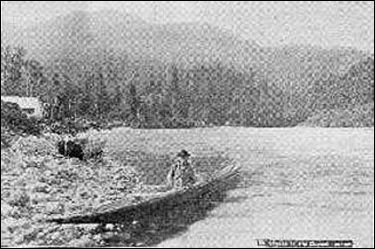 | This photo of an Indian canoe near Marblemount was taken by Darius Kinsey of Sedro-Woolley and appeared in Sebring's Illustrated magazine in 1902. See the story about Otto Pressentin and how he reacted to the 1897 Skagit River flood when he was a schoolteacher in Marblemount.
|
- Dick Harris shares a poem, This River Sings, from his upcoming book, drafted at the memorial service for his brother Jim. (With Jim Harris' obituary). His collection of poems, Reimagine, was published in 2010.
- The Rockport Hotel Fireof 1952, a profile of its owner Hugo Bauman, and memories of Will D. Jenkins. This story will soon be changed to this address. If neither file connects, please email us.
- Hugo Bauman and Will D. "Bob" Jenkins's tales of the upper Skagit. This story will soon be changed to this address. If neither file connects, please email us.
- Bessie Porter's memories of Sauk City, Rockport, Pressentins, Martins and the Great Northern railroad. And Ted Porter's memories and photos of Tom Porter and his famous cabin near Illabot Creek.
- R.I.P. Hazel Tracy, a lovely lady who lived in Marblemount almost all of her 91 years. She was the niece of the famous Sadie Silverling Cudworth, whose hotel and bar were a fixture there for more than 50 years. We are still working on a profile of Sadie, who certainly had pluck, making a life of her own while the elusive Mr. Cudworth went to Hollywood to build sets for silent movies. We hope a reader has some new information about her. We met a descendant of the family a few years ago, Sadie Sullivan, but we have lost touch. Please email if you can help.
- Otto Peterson, Marblemount pioneer, tells about marketing moonshine on the Skagit river
- Early history of Marblemount and the Buller family, which includes a story about Clark's Cabins and the indomitable Tootsie Clark.
- Tom Benton's story about his ancestors, A. von Pressentin and Ed Pressentin and their roles in the early growth of Rockport.
Cascade Pass and the 1895 (almost) wagon road
- Bert Huntoon, engineer and photographer of Cascade Pass, Fairhaven and Mount Baker. Member of the original field team to survey the proposed Cascade Road in 1895. This story will soon be changed to this address. If neither file connects, please email us. Being updated soon with the rest of the surprising story of his family, which we recently discovered.
- Chapter 4: Otto, settlers and Indians cross the Cascade Pass in 1877 for gold, bears and a goat that jumped in the boat
- Introduction to this Cascade Pass series, with links to all the stories about the 80-year process to build a wagon road, which finally became the North Cross-State Highway in 1972 and is now Highway 20, via Rainy Pass. More stories in series: Early Cascade road efforts. Journal research about the original 1895 Washington State Legislature appropriation and survey; background from regional writers, a 1903 Skagit Times story about the Goat Trail; Will D. "Bob Jenkins's story of the Devil's Elbow . . . Revived plans for the Cascade Pass wagon road before and after David G. McInytre's campaign. . . . Washingtonian magazine, a January 1929 article about the campaign that McIntyre led to kick-start the Cascade Pass wagon road. . . . David G. McIntyre profile and links about Skagit Steel & Iron Works. . . .
Links, background reading and books on Sauk City through Monte Cristo
- We now have a dozen Journal features about Monte Cristo, the Sauk-Suiattle river region and Sauk City. Instead of repeating all those source links on each website, along with references to books and back reading, we now have one central website with all the sources. This story will soon be changed to this address. If neither file connects, please email us.
- Our exclusive 4-part history of Sauk City on the south shore of the Skagit — which is now a pasture, and Sauk on the north shore, a railroad town, and the pioneer miners, farmers and storekeepers who braved the remote wilderness and the constant threat of floods on the trail to the Monte Cristo mines. Part of our 8-part Sauk section.
- A transcription of a Ray Jordan story about old Sauk City and the difficult transportation to and from.
- Old Sauk City and new (north-shore) Sauk memories of the Wainright and Gay families, with information by Diane Marie Wainright McMurdie, and a transcription of a Ray Jordan story about old Sauk City.
Illabot Creek
Dams, mines, passes Cascade river & Cascade mountains:
- 1870 survey of the Skagit River, North Cascades and lake Chelan by D.C. Linsley, Frank Wilkeson and others for the Northern Pacific Railway. And biography of D.C. Linsley., (1827-89),
- Nathan Edwards Goodell and his pioneer store on the upper Skagit River during the Ruby Creek gold rush of 1880. His trading post was located a mile north of present-day Newhalem, on the creek later named Goodell Creek; his location was called Goodell Landing. Included is the story of how August Dohne converted the store and site into a roadhouse for upriver travelers and miners. This story will soon be changed to this address. If neither file connects, please email us. We welcome reader suggestions and documents for upcoming stories on Newhalem, the Skagit Gorge, Diablo and the Seattle City Light dams.
- Frank Wilkeson takes his New York Times readers fishing on 6-Mile Creek in the North Cascades in 1890, after walking 14 miles through the forest to Hamilton. This story will soon be changed to this address. If neither file connects, please email us.
- Lucinda Davis, a divorcee from Denver, arrived at the Cascade River in 1890 with her children, Frank, Glee and Idessa, and they braved floods and fires to establish Cedar Bar, the most famous Skagit River roadhouse. Will be extensively updated in 2010; can you help?
- Fire Watch Towers of the Cascades. Betty and Cecil Hittson supplied scans of photos taken by her father Harry Osborne. And Maxine Meyers and Quentin Belles and others describe firewatching and firefighting experiences.
- Paradise of the Cinnamon Bears, number 13 in the series of Northwest stories by Frank Wilkeson, published in the New York Times, July 10, 1892, about hunting across Skagit Pass near Lake Chelan. This story will soon be changed to this address. If neither file connects, please email us.
- Capsule biographies of North Cascades pioneers, A-L in two parts.
- Backus Ranger Station at Marblemount, the portal to the Mount Baker and Cascades mountain districts. Along with information about the Bacon creek and Texas Pond substations and the work of the CCC in building many camps in the Cascades from 1933-38. This story will soon be changed to this address. If neither file connects, please email us.
- Part one of our exclusive section about Poets on the Peaks by John Suiter, the book about Beat writers Gary Snyder, Philip Whelan and Jack Kerouac and their years as firewatchers in the North Cascades from 1952-56. This story will soon be changed to this address. If neither file connects, please email us.
Links for Mines and Mining pioneers throughout the North Cascades
|

 ,
, 